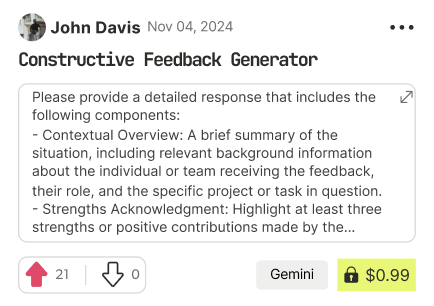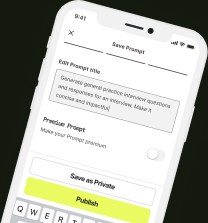prompt mine App
Find, Create & Share AI Magic
Career Crucible Report: Google Software Engineer Rejection
Okay, let's transmute this rejection into career gold. You received feedback: “We felt your experience didn’t align with our needs for this role” – applying for a Software Engineer position at Google. This isn’t a dismissal of your abilities, but a signal for refinement. Here’s your Career Crucible Report, broken down into Extraction, Element, and Forge phases.
Extraction Phase: Deeper Dive
The core reason is a perceived misalignment between your experience and Google’s requirements. Digging deeper, this likely means one or more of the following:
Specific Technology Stack: Google likely prioritizes expertise in technologies you haven’t prominently showcased (e.g., Go, Kubernetes, TensorFlow).
Scale of Projects: Google operates at massive scale. Your projects might not demonstrate experience handling comparable complexity.
Domain Knowledge: The role may require specific domain knowledge (e.g., distributed systems, machine learning) that isn’t evident in your background.
Cultural Fit (Implied): While not stated, "alignment" can subtly hint at a mismatch in problem-solving approaches or collaborative style.
Element Phase: Reframing Rejection Points
Let's translate these into actionable areas for improvement:
1. Technology Stack Gap: You need to demonstrate proficiency in Google’s preferred technologies.
2. Scale of Project Deficiency: You need to highlight or gain experience with large-scale projects.
3. Domain Knowledge Weakness: You need to acquire or emphasize relevant domain expertise.
4. Networking Deficiency (Potential): You may benefit from connecting with Google engineers to understand their tech stack and project needs.
5. Resume Weakness: Your resume isn’t effectively communicating your relevant skills and experience to Google’s standards.
Forge Phase: Actionable Steps
Here’s how to forge a stronger profile:
1. Technology Stack Gap (Focus: Go)
Skill to Learn: Complete a comprehensive online course on Go programming (e.g., A Tour of Go, Udemy’s “Go: The Complete Developer’s Guide”). Aim for project-based learning.
Person to Contact: Find a Go developer on LinkedIn working at Google and request an informational interview to learn about their tech stack and how Go is used.
Resume Tweak: Add a "Skills" section highlighting proficiency in Go (even if self-taught), and mention any Go-based personal projects.
2. Scale of Project Deficiency (Focus: Distributed Systems)
Skill to Learn: Take a course on distributed systems concepts (e.g., MIT 6.824). Explore open-source projects involving distributed systems.
Person to Contact: Connect with a software engineer specializing in distributed systems on LinkedIn and ask about challenges and best practices in scaling applications.
Resume Tweak: Reframe existing projects to emphasize scalability aspects. Quantify the size and impact of your projects (e.g., "Developed a system handling X requests per second").
3. Domain Knowledge Weakness (Focus: Machine Learning)
Skill to Learn: Enroll in a Machine Learning specialization on Coursera or edX. Focus on practical applications relevant to Google’s products.
Person to Contact: Reach out to a Machine Learning Engineer at Google via LinkedIn, focusing on their specific area of expertise and asking for advice on relevant learning resources.
Resume Tweak: If you have any ML-related projects (even small ones), prominently feature them, highlighting the algorithms and techniques used.
This report provides a starting point. Remember, every ‘no’ is a lesson. Every rejection, a refinement. Continue to iterate on these steps, and your next application will be even stronger.

Find Powerful AI Prompts
Discover, create, and customize prompts with different models, from ChatGPT to Gemini in seconds

Simple Yet Powerful
Start with an idea and use expert prompts to bring your vision to life!

